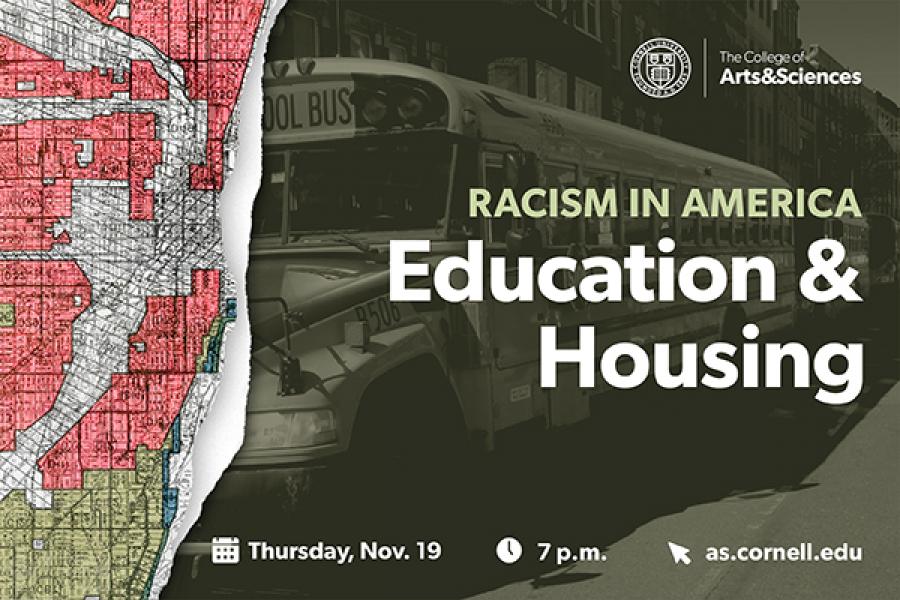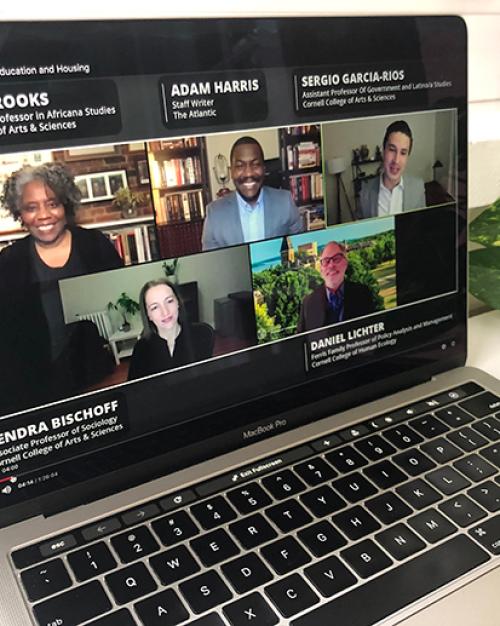Civil rights legislation and Supreme Court rulings have undone a history of legal racial segregation in America, but schools and neighborhoods remain largely segregated, four Cornell faculty members said during the Nov. 19 webinar, “Racism in America: Education and Housing.”
“Segregation is not today enshrined in law, but it is in force,” said Noliwe Rooks, the W.E.B. Du Bois Professor and director of the American Studies Program in the College of Arts and Sciences (A&S). “We rarely talk much, outside this panel, about segregation. As a result, many of us may think it’s gone away. But segregation is still very much with us.”
The webinar, attended by more than 800 people, was the second in the yearlong “Racism in America” series, hosted by A&S and supported by Alumni Affairs and Development, eCornell and Diversity Alumni Programs. The College of Human Ecology partnered with A&S on the Nov. 19 webinar.
Adam Harris, a staff writer for The Atlantic who covers education and national politics, moderated a wide-ranging discussion of residential and educational segregation along racial lines.
In addition to Rooks, panelists were Kendra Bischoff, associate professor of sociology (A&S); Sergio Garcia-Rios, assistant professor of government (A&S); and Daniel Lichter, the Ferris Family Professor of Policy Analysis and Management in the College of Human Ecology and faculty affiliate of the Cornell Population Center.
In America, Bischoff said, education and housing are inextricably linked to each other and to underlying social structures – the enduring and regular arrangements in society beyond the control of individuals.
“Racial segregation in schools and housing is supported by large income and wealth differences between white and nonwhite populations,” Bischoff said, adding that the American public education system is highly fragmented, with approximately 13,500 school districts across the 50 states.
“Where you live matters in so many ways,” said Lichter, who studies marginalized rural populations, including immigrant communities and reservations, which are “segregated, isolated and mostly invisible,” he said.
“Rural segregation and isolation is a direct result of legacies of slavery, racial oppression including land grabs of all sorts, and violence, the effects of which persist to this day,” Lichter said. “Racial inequality is built into our political and economic systems. It’s hard to change.”
Yet many immigrants to America seek positive change in the form of better education, Garcia-Rios said, noting that polls show education matters to and has mobilized Latinos.
The terms “Hispanic” and “Latino” came to exist, Garcia-Rios said, precisely because of the mobilization of marginalized and segregated communities that united to fight for bilingual education and other causes, “making it possible for this very diverse group of people to come together under one umbrella.”
Coming from these different points of view, the panelists agreed that economic disparities both contribute to and result from segregation.
“I call this ‘segrenomics,’” Rooks said, “and I think this mashup of segregation and economics is one of the underexplored reasons we can’t end segregation and move our justice needle forward.”
But if federal legislation aimed to root out racial segregation in housing and education – starting with the Civil Rights Act of 1964 – has not moved that needle, Harris asked the panel, what can be done? And what have communities tried?
Well-off school districts have historically resisted federal government intervention in schools, Rooks said. “It almost has to come from the bottom up, it almost has to come neighborhood to neighborhood,” she said.
Because federal government policy doesn’t do well on the micro level, she said, “I think there could be some creative ways that we redefine relationships between the federal government and the local, keeping equity central,” Rooks said, citing District 15 in Brooklyn, New York, where parents “met for years” to make education in their district more equitable.
School choice programs can unlink residence from education, Bischoff said, but don’t change the underlying patterns of residential segregation.
“On the macro scale, housing policy is a necessary part of that solution in order to change the underlying condition of residential segregation,” Bischoff said, suggesting zoning changes and programs to develop more affordable housing in high-opportunity areas.
Even segregated groups are influenced by the communities in which they live, Garcia-Rios said. He expressed hope for Latino communities, including immigrants, integrating with the places where they move for job opportunities.
“As more immigrants move to areas that were mostly white,” he said, “first we’ll see a negative reaction, but then incorporation and integration.”
In his studies, Lichter has witnessed connections between integration and economic growth in small towns where an influx of immigrants – some Hispanic but also those from parts of Asia and Africa – brought with them positive implications for school districts.
“The growth of more diverse communities – I call them ‘global small towns’ – actually lifts up the community overall,” Lichter said, adding that while local elites, usually white, resist at first, fearing for jobs, “in the end, some of those fears don’t seem to be realized. There seems to be a multiplier effect.
“I always say diversity starts from the bottom up,” he said. “It starts with the kids.”
The Racism in America website contains additional resources on these topics. Webinars planned for spring 2021 will discuss protest movements and civil disobedience; health care inequalities; and race and the economy.





